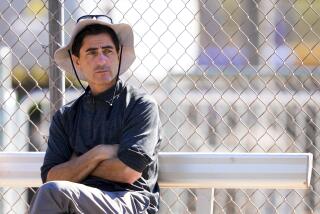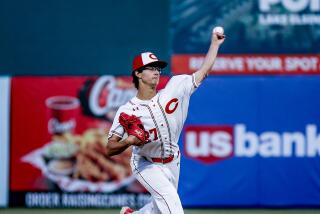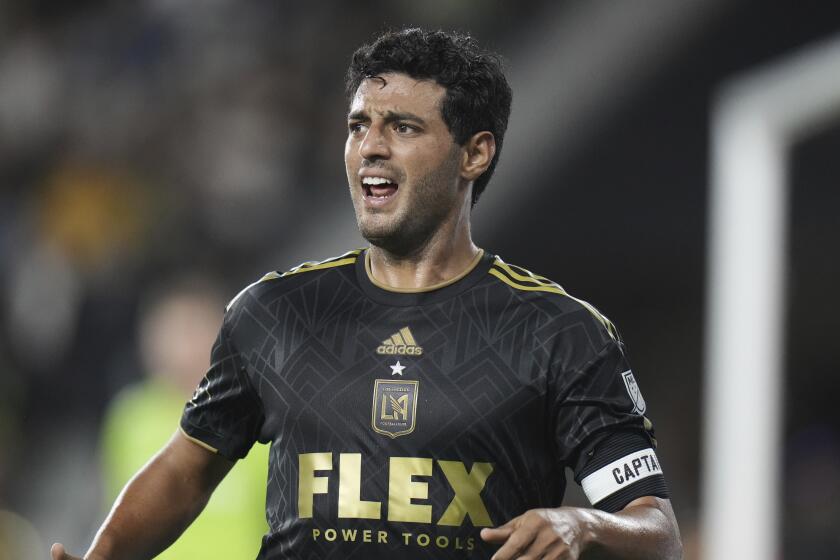Second Chance
- Share via
The way Jim Colborn tells it, David Newhan had a license to play second base.
And if he didn’t, Newhan might not be where he is today.
Newhan, a 1991 graduate of Esperanza High, made his major league debut with the San Diego Padres June 4 after a four-year rise through the minor leagues.
That rise, a sometimes turbulent, sometimes frustrating journey for the 25-year-old Yorba Linda native, might never have happened if not for the tale of a player, a coach and a car.
Colborn managed Newhan for two years in the Oakland A’s organization before a trade sent Newhan to the Padres.
A rash of injuries thinned Colborn’s infield depth at Class-A Modesto in 1996. Second baseman Fred Soriano broke his ankle, third baseman Jeff D’Amico injured his knee and shortstop Miguel Tejada dislocated his thumb.
Wondering what to do while strolling through the stadium parking lot on the way to practice, Colborn noticed an odd license plate: LV2TRN2.
Colborn deciphered “love to turn two” but it puzzled him.
“I thought, ‘Who the heck owns that car?’ ” Colborn said. “All my middle infielders are Dominican and none of them have cars.”
The intrigued manager entered the clubhouse searching for the owner and found that it was Newhan, an outfielder who had played second base in high school.
“So we started working with him,” Colborn said. “He was hitting well that year, but nothing like you want an outfielder to do. The numbers jumped out at you as a second baseman.”
Newhan finished that season batting .301 with 25 home runs, 75 runs batted in and 17 stolen bases. The next year, he batted .296 with 12 homers, 83 RBIs and 14 stolen bases at Class-A Visalia and double-A Huntsville.
As a second baseman he kept climbing. After a trade sent Newhan to the Padre organization, he played at double-A Mobile in 1998 and began this year at triple-A Las Vegas, where he was batting .307 with 10 home runs, 24 RBIs and nine steals when the Padres called him up to replace injured Chris Gomez.
“There’s no doubt that move [to second base] helped my career,” Newhan said. “We all thought it would be the best fit, my best chance to make it even if it was in a utility role.
“Being an outfielder you’ve gotta hit a lot of home runs or steal a lot of bases. As a second baseman you don’t have to do as much offensively. I figured I had nothing to lose by making the switch.”
In his Padre debut, Newhan entered the game in the eighth as a pinch runner for Jim Leyritz. He promptly stole second and scored the eventual winning run in a 3-2 victory over Seattle.
It was a day that many who have followed Newhan’s career thought might never happen.
As a 17th-round draft choice by Oakland in 1995, the scouting report on Newhan said he was too small (5 feet 10, 180 pounds) and too slow.
“He was never considered a prospect,” said Tony Attanasio, Newhan’s agent. “He was referred to as a filler. A lot of those low draft picks are taken because you need somebody for the $10-million first rounder to play with as they develop.”
Every place Newhan went, it seemed, the same scouting report followed. Even when he moved to second base, they said he was a poor fielder with average foot speed.
“The talk behind the doors,” Colborn said, “was that he was a good guy who could swing the bat a little, but doesn’t have a future. His name probably came up for release because he was never slotted for special attention.”
Newhan didn’t let it bother him. He didn’t read the reports, choosing to just play the only way he knew: hustling and working hard. He would be the first to show up at the field to get extra infield practice and studied the best hitters, fielders and baserunners.
He attended the fall instructional league in 1998, where he worked with Padre infield instructor Tony Franklin on ground balls, footwork and hand speed.
“It was a tough adjustment,” Newhan said. “The first year wasn’t too pretty, but Tony and I really hit it off.”
And Newhan refused to quit believing in himself, though sometimes it was tough. Long stints away from home, grueling trips and a year in Mobile, Ala.--a long way from Southern California geographically and culturally--made him wonder if the life of a minor leaguer was worth it.
When he started the 1998 season batting .200 for the first month he felt like giving up.
“I think everyone who ever makes it goes through that,” Newhan said. “This game beats you up, that’s no secret. But you just believe in yourself enough and remember that you are better than what you have been doing.”
Newhan has made a career out of proving himself.
He batted .421 with four homers and 28 RBIs his senior year at Esperanza, yet did not receive a Division I college scholarship offer and no pro teams showed interest.
After a year at Cypress College, an assistant coach from Georgia Tech noticed the left-handed hitting Newhan at a Connie Mack tournament in Las Vegas and offered him a full ride.
He didn’t want to go that far from home, but the idea of playing next to highly regarded shortstop Nomar Garciaparra was enough to convince him.
When he got there, they moved him to first base. Though he had a good year, he was miserable in Georgia so he asked out of his scholarship and transferred to Pepperdine.
In Malibu, he played second for a while but injuries forced him back to first base and eventually to the outfield, which is how he was drafted as a left fielder.
“We took him because we liked his hustle,” Colborn said. “We thought he would make a good fourth or fifth outfielder.”
No matter what he did, or what kind of numbers he put up, Newhan could not convince scouts that he was big league material. He had a solid season at double-A Mobile in 1998, batting .261 with 12 home runs, 45 RBIs and a career-high 27 stolen bases.
“All the while the reports kept coming in,” Attanasio said. “They all said, ‘Not a prospect, not a prospect.’ ”
But Newhan proved he was a prospect.
He tore up the Pacific Coast League through the first two months at Las Vegas this season, earning league player of the week honors by batting .467 with four home runs and eight RBIs in a seven-game stretch in May.
That got him to the promised land, where he said his stay so far has been pleasant.
“It’s been a blast just meeting the guys and getting to see what it’s like being a big leaguer,” he said. “I could get used to staying here.”
The pranksters who normally prey upon rookies have not yet made their way to Newhan’s corner of the locker room. No shaving cream pies in his face, no stolen clothes.
Perhaps pranksters fear Newhan’s high-profile connections. David’s father, Ross Newhan, is the national baseball writer for The Times.
Though his family ties have the potential to cause tension in a professional sports world with a reputation for mistrust of the media, Newhan said he is not concerned.
“I don’t know if anyone notices,” he said. The younger Newhan admits that he pays little attention to what his father is writing.
“I read a little bit, but I don’t get into the paper too much,” he said. “I look at the box scores, but I don’t bust out and read stories too often.”
“I’m a position player, I get my news from ‘Sportscenter.’ Pitchers read the paper.”
Position players read box scores. Pitchers read the paper.
And, luckily for Newhan, coaches read license plates.
More to Read
Go beyond the scoreboard
Get the latest on L.A.'s teams in the daily Sports Report newsletter.
You may occasionally receive promotional content from the Los Angeles Times.










